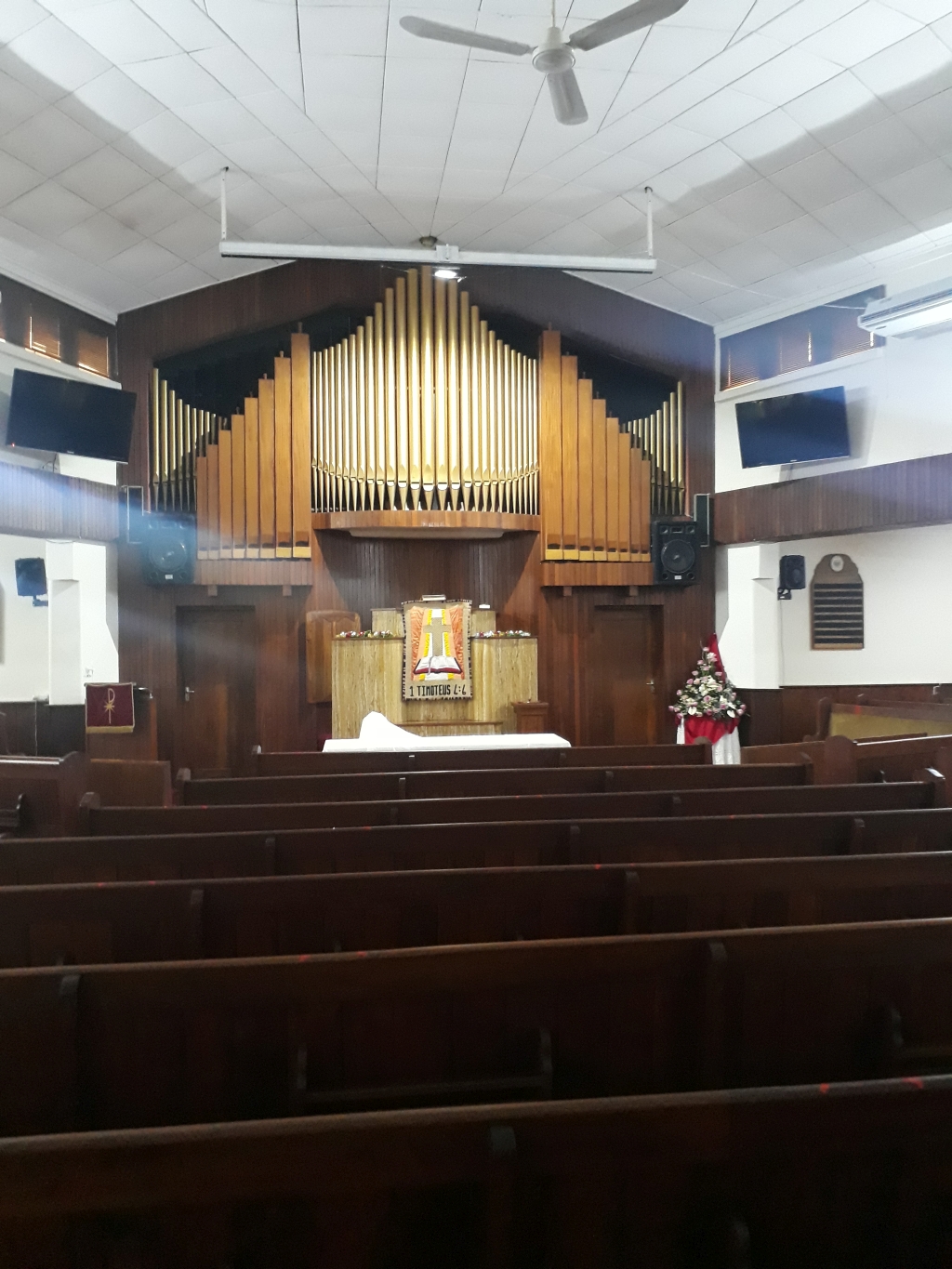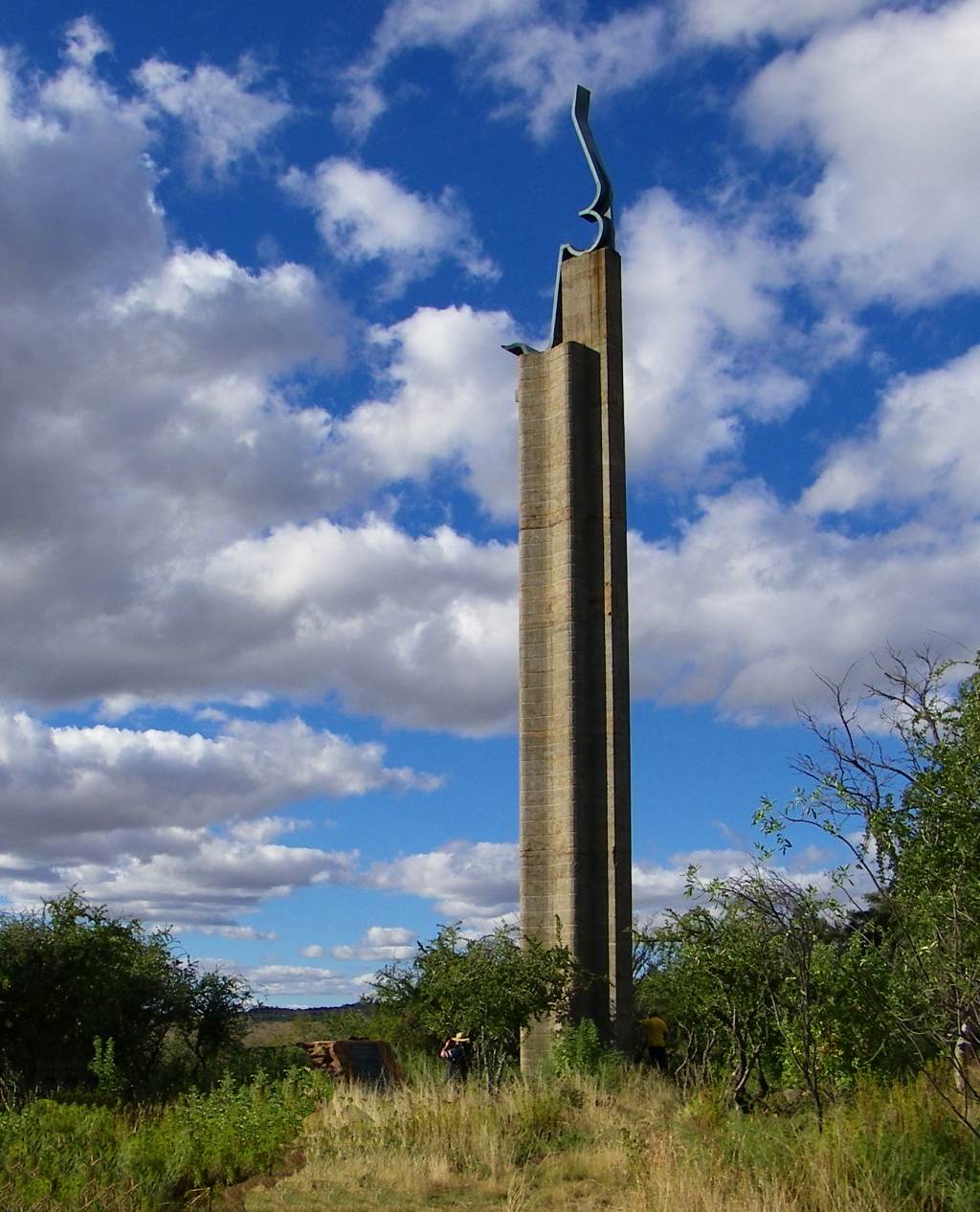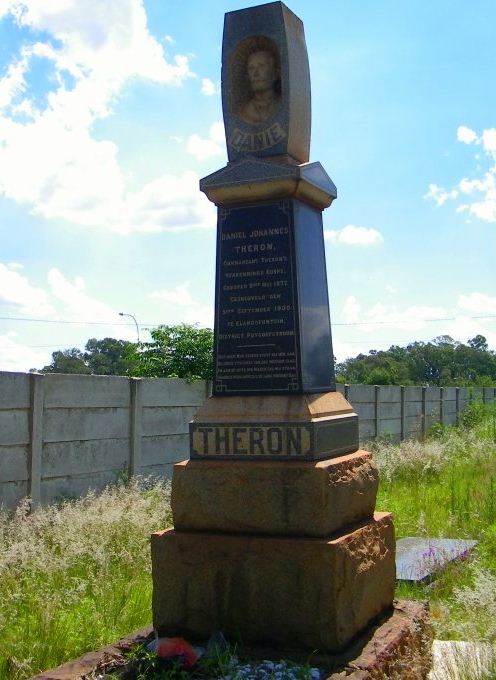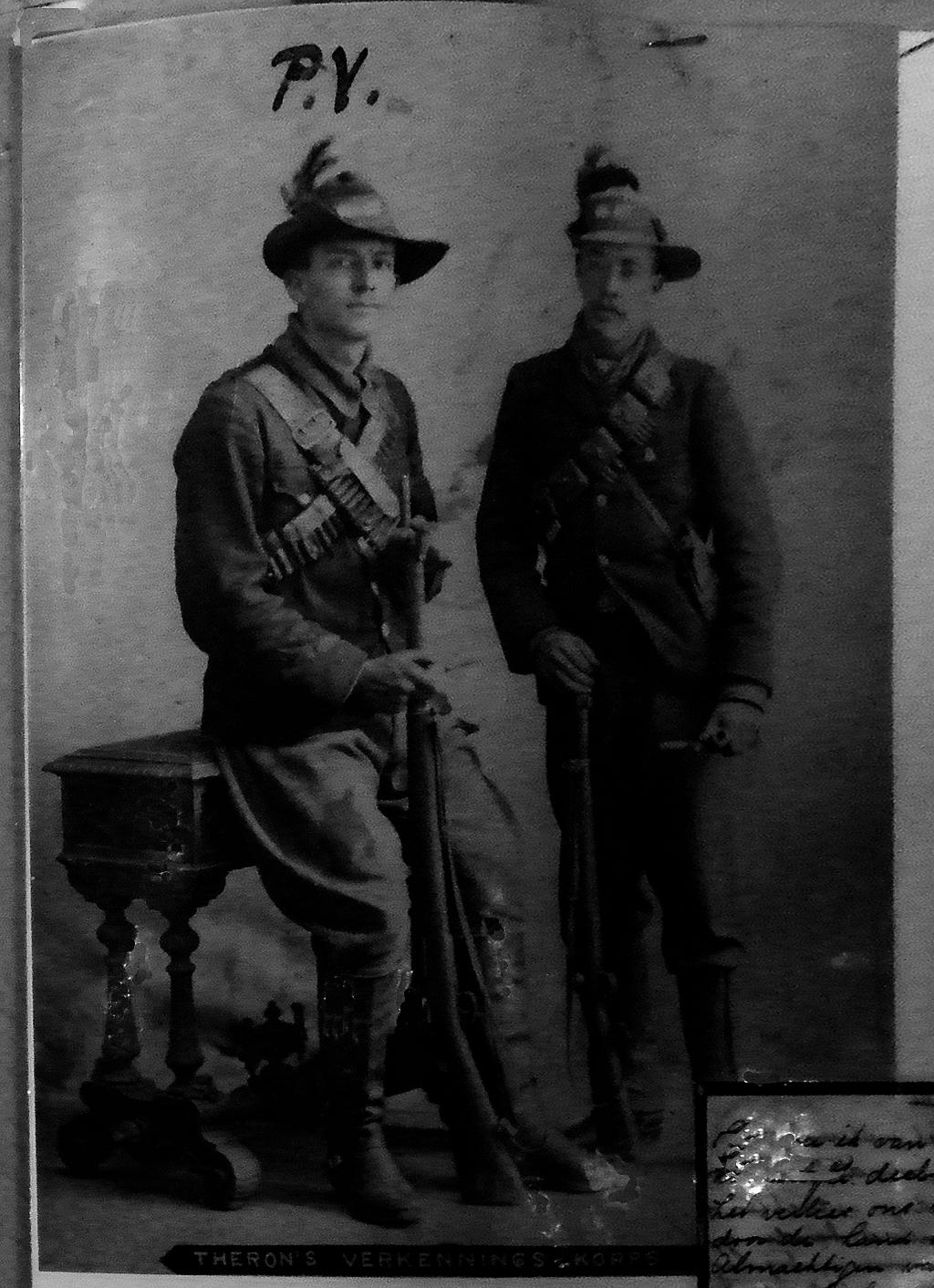
Fochville
Fochville could be called a mining town, but this is not how it started. It was established in 1920 to serve as an agricultural centre. The gold mines of Carletonville only came later in the 50th of last century. Its location: 26.4927°S, 27.4949°E and 1474m altitude.
NH church

 That is the Nederduitsch Hervormte Kerk, one of the sister churches first established in Potchefstroom.
Members of the NH church living in the area were members of the Potchefstroom congregation. With the establishment of the town Fochville the numbers became strong enough to think about forming a new congregation by ceding from Potchefstroom. The new congregation of Losberg was officially established on 16 May 1925.
Initially, they used an existing church constructed from corrugated iron sheeting. The source (Ref 3) is not very clear where the church suddenly came from. One has to assume that it was there from earlier times to serve the sub-congregation of Losberg. In the source, it is stated that they requested the Potchefstroom church council to use this building.
That is the Nederduitsch Hervormte Kerk, one of the sister churches first established in Potchefstroom.
Members of the NH church living in the area were members of the Potchefstroom congregation. With the establishment of the town Fochville the numbers became strong enough to think about forming a new congregation by ceding from Potchefstroom. The new congregation of Losberg was officially established on 16 May 1925.
Initially, they used an existing church constructed from corrugated iron sheeting. The source (Ref 3) is not very clear where the church suddenly came from. One has to assume that it was there from earlier times to serve the sub-congregation of Losberg. In the source, it is stated that they requested the Potchefstroom church council to use this building.
The congregation went to work making improvements to the building, including the installation of electric light.
Already in 1933, the church council started thinking about building a new, bigger church. A building fund was started. The foundation stone was laid on 17 September 1937 and the inauguration was on 14 January 1938. Architects were Geers & Geers and the builders JG Enslin & Seun.
NG church
 When the congregation of the NH church was started there was a concern that some of it's members would change over to that church. Thus efforts where being made to form a new congregation which was to be known as the Losberg congregation. 1931 a church hall was built in Fochville, just over the road across from the present church. This served the local community as church. Eventual the congregation was officially formed in 1935, it was achieved by ceding from the mainly Mooiriver and Potchefstroom congregation, and by also getting pieces from Roodeport and Vereeniging.
When the congregation of the NH church was started there was a concern that some of it's members would change over to that church. Thus efforts where being made to form a new congregation which was to be known as the Losberg congregation. 1931 a church hall was built in Fochville, just over the road across from the present church. This served the local community as church. Eventual the congregation was officially formed in 1935, it was achieved by ceding from the mainly Mooiriver and Potchefstroom congregation, and by also getting pieces from Roodeport and Vereeniging.
Planning to build a church was under discussion already in 1938, a building fund was started in 1943. Actual building was started in 1952 and the inauguration was on 29 May 1953. The archidect was Hendrik Vermooten. Building costs were £19720 plus cost of interior and other incidental expediture brought the total to £28000.
Danie Theron monument

 About 7 km North-West from Fochville, next to the N12 is a monument, a monument erected at the place where Danie Theron was killed in action in 1900, during the Anglo Boer war. He died when he came across a group of British scouts, he was alone and tried to fight his way out.
About 7 km North-West from Fochville, next to the N12 is a monument, a monument erected at the place where Danie Theron was killed in action in 1900, during the Anglo Boer war. He died when he came across a group of British scouts, he was alone and tried to fight his way out.
In civil life before the war he was a lawyer in Krugersdorp. In the war he made a name for himself as a scout and formed the Theron's scouts, a group that helped the Boers to know where and what the enemy was doing. He was well respected by friend and foe, so much so that the British offered an reward for his captured, alive or dead.
Next to the monument is a plaque which explains what happened here, following is a translation: This monument was unveiled on the 5 September 1950, exactly 50 years and 4 days after the heroic act of Danie Theron - famous scout of the Boers in the Anglo Boer war, on the hill known as Theronskop.
The column consists of 50 rings, which represents the 50 years since September 1900.
The metal sculpture on top represents a flame, the flame of freedom which burned in the heart of Danie Theron and the Boers which were defending their freedom, independence and their flag.  The ownership of this terrain was transferred in 2003 from the Transvaal Voortrekkers to the Heritage foundation.
The ownership of this terrain was transferred in 2003 from the Transvaal Voortrekkers to the Heritage foundation.
Builder: L.Fokkers(Pty)Ldt
Architect: Mr. Hillebrands, Krugersdorp
Funds collected by 'Die Voortrekkers'
To complete this story, after resting in a grave nearby his remains were reburied in the Eikenhof cemetery, it is at the crossing of the R82 and the R554 in the south of Johannesburg. The inscription on the grave stone, translated, reads (semicolon indicates line break): Daniel Johannes; Theron; Commander of the 'Theron scouts'; born 9 May 1872; killed in action 5 September 1900; at Elandsfontein; district Potchefstroom
There is a verse underneath which I find difficult to translate. I have given this to my friend Frans (he originates from Holland)) to do.
Piet Vermaas
 I wanted to write about Pieter Vermaas, because he wrote a letter which is on display in the house at Waenhuis in the Losberg. The picture only shows the 1st page, there are 3 pages altogether. Piet grew up on this farm, at the time he wrote the letter, dated 14 September 1899, he was studying theology in Stellenbosch in the Cape. With war seemingly imminent and unavoidable he wanted to know from his dad what he should do. He felt he couldn't stay in Stellenbosch and should rather come and help defend the independence of the Republic.
I wanted to write about Pieter Vermaas, because he wrote a letter which is on display in the house at Waenhuis in the Losberg. The picture only shows the 1st page, there are 3 pages altogether. Piet grew up on this farm, at the time he wrote the letter, dated 14 September 1899, he was studying theology in Stellenbosch in the Cape. With war seemingly imminent and unavoidable he wanted to know from his dad what he should do. He felt he couldn't stay in Stellenbosch and should rather come and help defend the independence of the Republic.
 I have translated the letter, but I am not happy that I have done it correctly, there are a few words I cannot make out and others once translated make no sense. I will make an other effort and correct when I get around to it, I will asked Frans to assist. So, here is my translation and interpretation:
I have translated the letter, but I am not happy that I have done it correctly, there are a few words I cannot make out and others once translated make no sense. I will make an other effort and correct when I get around to it, I will asked Frans to assist. So, here is my translation and interpretation:
Stellenbosch
14 Sept 99
Dear Parents,
I have been looking forward this week to a letter from home, everything now seems to be so pointless. I am shrouded by God's grace and love and know that you all share in his mercy.
It looks to me that war is inevitable, since England is making such strong demands on the Transvaal. It is not possible for the Transvaal to agree to all of them. And also to immediately wanting an answer. It will thus not take long for them to declare war.
Dear Dad and Mom, your ability has always had the upper hand, thus I am not afraid.
But it torments me to think how many lives and tears must be sacrificed, and all that because of some greedy people.
In my life I have gained a lot from our independence and will, with God's help, do my part to preserve it. May the Lord forgive me if I make too much of my country.
?unreadable?
Dear Dad, please send me the money before the end of the months, so that I can get it before the vacation, since I have nothing in my pocket.
Let me know what to do in case war breaks out. I do not wish to stay here.
?unreadable, something about a pity if he has to leave, but that can't be helped?
Greetings to all
Pieter Vermaas
I don't know when he got to the Transvaal and how, but he obviously made it. The picture on the right shows him as a member of the Theron Scouts ( see the Danie Theron monument above). There are two more letters on display, dated 28 March and 4 May 1902, they were sent from the prison camp in Bermuda. These are even more difficult to read. Thus I don't know where and when he was made prisoner. There is mention in the letter that he last saw his mom on the 23 December 1900.
From a newspaper clipping also on display, we know that he didn't come home from Bermuda but decided to go into exile in North America. Eventually he did come back to his home country and joined the South African army. He went with Smuts to German South West Africa in 1914/15 and later into German East Africa (Tanganyika). The highest rank he obtained was that of major. He did get back to civilian life, farming on Rhenosterfontein, which is the farm covering most of the Losberg mountain. In the area he was active in politics, first in the SAP (South African party) and later in the United Party.
He died at the age of 83, I have no dates, but an estimate would put he year of death in 1963.
Railway station
 The railway line from Potchefstroom to Fochville was inaugurated on the 14 April 1928. The station is about 10km south from the town. The line was extended to Vereeninging in 1965. The station is not in use now.
The railway line from Potchefstroom to Fochville was inaugurated on the 14 April 1928. The station is about 10km south from the town. The line was extended to Vereeninging in 1965. The station is not in use now. 
A interesting piece of graffiti noticed at the goods shed (picture on the right), I am not going to transcribe it, you have to read it for yourself. Read from the bottom up to make sense. You may have to enlarge the picture to make it readable. With my sense of humour I find this quiet funny, but other readers may not think so.
Losberg
 The Losberg, about 10 km south of Fochville, is bit of a geological curiosity. Its name Losberg means loose mountain, a mountain that stands all by itself in an otherwise flat country side. It is an upliftment related to the formation of the bushveld complex about 2 billion (109) years ago.
The Losberg, about 10 km south of Fochville, is bit of a geological curiosity. Its name Losberg means loose mountain, a mountain that stands all by itself in an otherwise flat country side. It is an upliftment related to the formation of the bushveld complex about 2 billion (109) years ago.
In human history, before the whites came, it was the place where chief Mare of the Kwena tribe settled at around 1823 and stayed there until about 1930 when under the pressure of the Mzilikazi raids they moved south into the Free State and Lesotho. The ruins of their buildings can still be seen at Waenhuis, see picture. It is very difficult to see any structure and layout, also from Google Earth nothing is recognisable because of the bush and grass.
References:
Ref 1: Standard Encyclopedia of Southern Africa, Nasou Limited, 1974
Ref 2: Halfeeufees N.G.Kerk Losberg, 1985
Ref 3: Fyftig Jaar Gemeente Losberg, Ned.Herv.Weeshuispers, 1975
Ref 4: Elize Sonja van Eeden, "DIE GESKIEDENIS VAN DIE GATSRAND", Verhandeling goedgekeur vir die graad MAGISTER ARTIUM in GESKIEDENIS in die FAKULTEIT LETTERE EN WYSBEGEERTE van die POTCHEFSTROOMSE UNIVERSITEIT VIR CHRISTELIKE HOER ONDERWYS